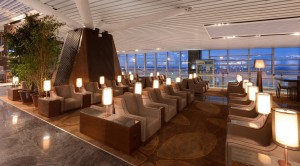



The world’s leading airport lounge provider, Plaza Premium Lounge, will be opening at London Heathrow T2 in June 2014. Priding themselves on a quality of service which is trusted and welcomed by travellers across the globe, Plaza Premium Lounge is the industry leader in Premium Airport Services. Business travel is constantly evolving and with the current economic climate the centre of attention when budgeting for expenses, today’s business traveller is faced with fewer environments to rest, refresh and re-charge not only one’s own batteries but the energy cells of technological gadgetry used in everyday communication. But this concept is innovative, the company is the world’s first commercial VIP lounge for all travellers, irrespective of their airline or class of travel.
With 16 years’ experience in caring for travellers, Plaza Premium Lounge sets the benchmark for a luxurious and accessible airport experience. The Plaza Premium Lounge at London Heathrow T2 will be the Hong Kong-based company’s first venture in Europe and the only independent lounge at Terminal 2. There will be three phases to the opening strategy. In summer 2014, Plaza Premium Lounge will open in Departures, Lounge A3 (next to the terminal transfer desks) on Level 4. In Autumn 2014, a Lounge will open in Terminal 2 Arrivals and offer day hotel facilities for travellers, completing the phases with another Lounge opening in Terminal 4 in winter 2014.
Mr Song Hoi-see, the company founder and CEO of Plaza Premium Lounge told me “I’ve been a business traveller for many years and it was becoming increasingly difficult to find an environment where I could take time to relax before my connecting flight, perhaps re-charge my cell, take a shower… I realised this was a problem for all travellers, business or pleasure, so I researched the requirements and came up with the concept of Plaza Premium Lounge.”
Open daily from 5am to 11pm, the £38 charge per person allows access for up to two hours which includes a complimentary selection of food and drink including tapas and freshly baked artisanal breads, showering facilities (five luxury shower rooms with full amenities), use of the lounge facilities and business facilities (computer workstations, high speed Wi-Fi, charging sockets and full flight information), and entertainment in the form of TV channels, international magazine and newspapers. Also available at extra cost is a selection of vintage and non-vintage Champagnes at the Champagne Bar, an exclusive treatment menu by British organic spa brand, ILA, in the Wellness Spa and five private en-suite relaxation rooms.
With 110 locations in 29 international airports throughout the world and a development pipeline of 50 more lounges by 2015, Plaza Premium Lounge will become synonymous with luxury service at an affordable price.
To book, email uk@plaza-network.com
Website: www.plaza-network.com
Tag Archives: heathrow
Erin O’Connor Unveils Personal Shopping at Heathrow
We went along to see Erin O’Connor unveil personal shopping at Heathrow International airport. I had a chat with some of the personal shoppers, who let me know that animal prints, silks and print are going to be huge trends into 2014.
In an international airport first, customers can now enjoy Personal Shopping at Heathrow with an accredited stylist, free of charge and individually tailored, ensuring passengers can make the most of the precious moments before take-off.
The ground breaking Personal Shopping service at Heathrow brings together over 300 outlets at the airport with a bespoke consultation that can be booked ahead of time or accessed on arrival at the airport. Supermodel sensation, Erin O’Connor, who co-hosted an event at Somerset House to launch Heathrow’s new service, shared her experiences of how helpful the expertise from personal shoppers is to her;
‘Travel has been and still is a huge part of my life. The Personal Shoppers at Heathrow have incredible fashion and beauty insight which means they can pull a selection for me before I even arrive at the airport. I can make the most of my time before I board my flight and know that I will have everything I want for my trip.’
Whether it’s an extraordinary dress for an evening event, a new season update or even advice on the latest beauty trends, the airport’s Personal Shoppers are available from the first to last flight. Fluent in Russian, Arabic, Mandarin, Spanish, French, and Portuguese, Heathrow’s multilingual team are qualified to assist passengers from right across the globe.
Personal Shopping is just the latest of a range of unique services designed to help Heathrow passengers make the most of their time including:
- Home delivery
- Online product reservation
- Free beauty treatments
- Shop and Collect
Some of the available brands and treatments are below.
| Brand | Treatment |
| Estee Lauder | The Estee Lauder 5-step face Look more even toned instantlyFatigue FighterInstant Line Smoother
Make Makeup Last Beautiful Eyes Made Easy Simple Smokey Eyes Advanced Night Repair Skincare Advice |
| Crème De La Mer | Where Miracles BeginAgeing InterruptedBright Future
Eye Focus Deep Calm Hand And Arm Indulgence |
| Chanel | Specialist consultations in:SkincareMakeup
Fragrance |
| Lancome | AurasMini MakeoversSkincare consultations |
| Clinique | 3-step consultationFoundation fittingCreating a smile
Tape test Brighter eyes |
| Christian Dior | Complimentary makeovers |
| Yves Saint Laurant | Skincare and makeup |
| Clarins | Skincare consultationsAnti-ageing |
| M.A.C | Complimentary makeovers |
| Jo Malone | Complimentary hand and arm massages |
| Bobbi Brown | Instant prettySecret to perfect skinCheeks and Lips
Smokey eyes Teenage Beauty Bridal makeup party Pretty powerful |
| CLARINS | Skincare consultationsAnti-ageing |
| Sisley Paris | Make oversRefresh & Fly mini facialsHand massages |
| Guerlain | Instant Skin Bronzing |
| Benefit | Fake itFix itMaking the best of your brows |
| Elizabeth Arden | Skin Scanner DiagnosticPersonal regime demonstrationsFace finishing- powder or bronze |
| Biotherm | Flight planning for your skinSkin hydration checking and personal routine planning |
| Tom Ford | Colour demonstrationFull Tom Ford LookLip Demonstration
Eye demonstration Private blend fragrance mixing lesson |
| Kiehls | Skin ConsultationFacial for me or womenHand massage |
| Elemis | Hand and Arm Massage Mini FacialsEye treatment |
| Dr Sebagh | Mini Facial |
| Dermalogica | Face Map Skin AnalysisPre Flight prep treatment |
Making ‘Make-Do-And-Mend’ Sociable Again
The make-do-and-mend movement is back. When the recession began, clever marketing people at John Lewis dug out and republished a 1943 governmental booklet on how to darn socks and re-patch roofs using wastepaper. World war two kitsch was duly rekindled there has been since 2009 an unrelenting stream ‘make do and mend’ media output. Channel 4 a launched a ‘Make Do And Mend’ TV show advising viewers on how to have fun with frozen vegetables. Joan Bakewell has recently joined the celebration of frugality with an article in last week’s Telegraph, describing valiant efforts to deliver parcels by hand.
Yet modern make-do-and-mend lacks the defining feature of its 1943 counterpart. The earlier version came out of the war effort and was predicated on a sense of community spirit born out of a need for help on the home front. Food was scare so city dwellers pulled together to turn parks into vegetable gardens. Clothes were rationed so women ran up their own or darned holes in what they had. However, these activities took place in the context of pre-existent community structures like church groups, knitting circles, the Women’s Institute, and the Women’s Royal Naval Service which made skill-sharing easier and reduced costs. The acquisition of a new skill takes not only time but patience and we are far more likely to succeed within a supportive social framework than of we go it alone. Watching someone whip up a pair of curtains on television is not the same as being shown how to do it first hand. At the very least, observes Joy Pite from the Wanstead Women’s institute, ‘in a social setting, there’s more incentive to complete the task’.
Modern make-do-and-mend is the DIY craze of the 90s clothed in rather more frayed robes, due to an absence of community space. Most neighbourhoods during World War 2 had thriving churches and community centres, which made for strong and intergenerational social networks. These days people are working longer hours, spending their free time online, moving around more and therefore feel a decreased sense of affiliation with those in their physical surroundings.
This is what the organisers at Heathrow Grow are trying to remedy in the London suburb of Sipson. Heathrow Grow is predicated on the idea that cost-efficient and sustainable living requires somewhere for people to meet regularly and face to face. ‘It’s a lot easier to demonstrate things to people than it is to explain them’ says Alex, one of the project’s architects, ‘and it’s a lot cheaper to organise things as a group’. Built on an acre of land that was once an abandoned plant nursery, Heathrow Grow consists of a thriving vegetable garden and two greenhouses that have been transformed into workshop space. Its organisers have set up free classes on the basic principles of growing food, how to maintain a bicycle and even how to weld.
The Heathrow Growers have worked hard to convince the people of Sipson that community spirit is the key to the making daily life not only cost-efficient but ecologically sustainable. They have promoted the project by handing out free vegetables at the village market and have successfully involved themselves in the local Residents’ Society, Allotment Society and Young People’s Society. Local residents frequently come by make use of the facilities on offer or just to hang out and the site has proven particularly attractive to “N.E.E.T.S” looking to pick up new skills. ‘It’s great here’, explains Dan, an unemployed resident of Sipson who has recently become involved with the project. ‘I help out with the gardening. And it’s nice to have somewhere to potter around’.
Although the political outlook held by most of the project’s participants does not cohere with that expressed by the current government, Heathgrow Grow actively embodies many of Cameron’s ‘Big Society’ values. According to the the government’s online mission statement, the ‘Big Society’ exists to ‘give individuals more power and responsibility and use it to create better neighbourhoods and services’. Since Heathrow Grow has done far much more than the make-do-and-mend-movement to make this happen, those of us hoping for not only more financially efficient households but also the revival of flagging community spirits look forward to seeing more like it.
Plans to build a third runway through Sipson threaten Heathrow Grow’s continued existence. Its fate will be determined at Central London County Court on 18th and 19th June 2012. Sign their petition at: http://www.transitionheathrow.
WEST END STYLE COMES TO HEATHROW
A brand new bar has opened at the Radisson Edwardian Heathrow Hotel, bringing West End style and panache to the UK’s busiest airport.
The designers of Bijou Bar have created a “jewel” within the 4 star hotel renowned for it’s spacious and luxurious events spaces. The Bijou Bar features opulent silver fabric wall coverings and a mirrored champagne and spirits bar creating an intimate and sophisticated stop-over for both flyers and locals.
“We aren’t like the airport lounge-style open plan bars known around Heathrow” said General Manager Gavin Sanders. “We’re more like a private club; intimate, stylish and with a cool vibe.”
A striking chandelier is the statement piece of the room and is positioned below a multi faceted mirror, which throws shimmering light across the room.
An impressive cocktail list and champagne menu makes the bar a destination for celebrations, after meetings, pre and post flights or just for the sheer enjoyment of relaxation in the most gorgeous room at the airport.
“We’re incredibly excited about the opening of Bijou and the response from guests and the local community has been really positive which makes it all worthwhile.” Mr Sanders continued.
The recent new look at the hotel has extended to dining too with designers having unveiled a brand new style and feel in the Brasserie earlier this year.
Bijou is open from 5pm until 1am Monday-Friday and 8am-1am Saturday and Sunday. To book a table call 0208 7577 917 or visit www.radissonedwardian.com.
Heathrow's Third Runway: The Battle for Sipson.
When the Labour government finally dragged its heels from 10 Downing Street in May, one of the most contentious environmental issues of its time appeared to go with it.
Prime Minister David Cameron had barely crossed the threshold in place of the departing Brown, before the coalition government promised it would scrap plans for Heathrow’s third runway – an environmental battlefield in a war that had raged for almost a decade.
The defeated British Airports Authority (BAA) announced it was withdrawing its application soon after.
For the residents of Sipson and Harmondsworth – two villages in west London that lay directly in the path of the proposed project – it was a victory long in the making.
Six months on, it would be expected that any visitor to Sipson would encounter a community bubbling with renewed enthusiasm and vibrancy after losing the dark shadow hanging over their everyday lives.
Instead, it comes as a shock to find the polar opposite. From the jaws of defeat, BAA may yet win an unlikely victory.
A potted history of the conflict reveals the Labour Government first considered building a third runway in 2002. A flawed consultation document eventually followed in 2007, which became the catalyst for heavy-hitters Greenpeace to get directly involved in the campaign to stop Heathrow expansion.
Greenpeace’s Anna Jones reflected on the mood at the time: “The public consultation didn’t allow people to say ‘no, we don’t want it’, but instead said, ‘if we‘re going to build it, how should we build it?’ she recalls.
“The public opposition then really began to develop and it was around that time that we had the idea of Airplot.”
Pulling in a cross-section of political figures, celebrities and environmentalists, Greenpeace trumped the Government’s highly controversial green-lighting of the project in January 2009, by revealing their own purchase of a field directly in the runway’s proposed path.
Christened Airplot, the site soon became a focus for resistance to the runway, both directly and indirectly, with Greenpeace offering the opportunity for people to become beneficial owners of the site.
“In the first week, it was crazy and amazing,” says Jones. “A thousand people an hour were signing up to become owners at one point. And I think it really gave people hope and something concrete to do to stand in the way of the plans.”
Residents too, welcomed Airplot with open arms.
“We wrote to every single person in the village letting them know we were there,” she adds. ”Everyone was very supportive.
“There were some people who were feeling trapped by the blight situation and some who felt they just wanted to give up. But all the work the action groups and Airplot did, really boosted the morale of the local community and made them feel even stronger.”
Also joining the fray were activists Transition Heathrow.
The group swooped on a local derelict market garden site in March 2010 during the height of the fight against the runway and were determined to stay.
After removing 30 tonnes of rubbish and surviving an early court battle by the landowner to remove them, they have transformed the area into Grow Heathrow, which has become a community hub in a short space of time, visited by a number of Sipson’s home owners every day.
Transition Heathrow’s spokesman, Paddy Reynolds, explains: “We wanted to start something in the village that would capture some of the radical energy roused by the third runway campaign.
“They wanted tarmac and planes, and we wanted a sustainable, grass roots level, democratic community, that can look after itself in the face of local and global challenges.
“However, we didn’t want to just storm in,” he explains. “We knew a lot of people in the area through the campaign and spoke to everyone we knew about this site.”
“It had been used by an outfit that got evicted by the council. It was very unpopular, because there were noise abatement orders, illegal scrapping of cars and a lot of rubbish dumped, with people going in and out all the time.
“So we thought, ‘this is a very anti-social site, let’s make it very social. We’ll occupy it, clean it up and turn it into a community market garden’.
“It’s one of the last standing of these old market garden greenhouses, so it’s symbolic.”
Since March, the site has altered beyond recognition, becoming a genuine window into Heathrow’s past as prime arable land.
Airplot too, continues to grow – with a thriving orchard and returning wildlife – and with Greenpeace’s presence in the area now much reduced, Anna Jones believes the village is enjoying some quiet time.
“I think everyone’s very happy now just to be able to live their lives and breathe – which they haven’t been able to do for so many years,” she suggests.
“That’s fair enough when you’ve been at the centre of controversy for so long.”
But the truth appears to be much less rosy.
The centrepiece of the village, the listed, 400-year-old King William IV pub became an unofficial meeting place during the fight for survival, but a Friday lunchtime visit gives the impression that all is not well.
Close to 1pm, the pub is empty. A passer-by drops in for a quick pint and eventually three or four residents drift in. The mood is not optimistic.
Landlord Shaun Walters, after leaving Sipson in 1996, returned to the uncertainty in 2006.
“All that time, it’s been ‘is it or is it not coming’, but certainly in the last four years, it’s been more in the public eye.
“For me, it’s been a nightmare, business-wise. I’ve sold my house today, but when the guy came round to sign off everything, he said there are 32 houses unoccupied, all bought through BAA’s Bond Scheme. Some have been empty for four months, so I’ve lost revenue.
“For the businesses left in the village, it’s just devastation,” he adds. “I can see me being out of business after Christmas.”
And the government-approved Property Market Support Bond Scheme has proved to be BAA’s ace in the pack.
With buyers shunning a potentially doomed village, BAA offered residents a way out with the scheme, buying their properties at 2002 prices.
The coalition’s stance has since led BAA to limit residents to a deadline of June 22 to opt in, but a caveat in their letter advisees residents to continue to register their interest, in case of a future planning application.
And the inescapable irony is that, since the election, many residents have taken up the offer.
The legacy is rows of empty houses, while others are rented on short-term lets to migrant workers who have no stake in the long-term future of the community.
“I think a lot of people had had enough over the last couple of years and just wanted to go,” offers Walters.
“They wanted to go and live the dream somewhere else, and never have the heartache and grief of waking up in the morning, and thinking is it or isn’t it going to happen?
“But the big change is that it’s no longer a community. I don’t know a third of the people in this village now.”
One resident, speaking anonymously, agreed. “It’s dying from the inside,” she said. “I’ve sold my house to BAA. My neighbours have gone. Nobody wants to be here anymore.”
Transition Heathrow’s Reynolds is also well aware of the malaise that is creeping across Sipson.
“The Bond Scheme is self-perpetuating and causes more blight,” he says. “People who have been stuck in their houses for ten years have suddenly been given a small window of opportunity where they can sell at a good market rate at a time when the market’s crashing.
“It’s ‘take it or leave it’ and if you leave it, you might not get a better offer ever again.
“It’s meant that a lot of people have left en masse and that’s not good for any village. It’s especially unhealthy for the power dynamics, because BAA now own a lot of property here.
“The loss of long term residents is not helpful for the general well-being of Sipson. Families who know the history of this village is what binds this place together. That’s been lost.”
And most telling is that a number of people directly involved in the campaign have taken the opportunity to go.
Linda McCutcheon, the former chair of the Harmondsworth and Sipson Residents Association, is perhaps the biggest loss to the area.
“I knew Linda really well,” says Reynolds. “She was tireless in her support of us and anyone opposing the campaign.
“She was also on the committee for the No Third Runway Action Group (NoTRAG) which closed recently, but she’s moved out to enjoy her retirement.
“The previous chair of the residents association had family losses directly related to worsening health and stress caused by campaigning.
“Some of them sacrificed their retirement years, while some of them literally sacrificed their health – and ultimately their lives.
“Fair play to Linda. She deserves it, but the combination of circumstances means that it feels like a big change at the moment and we don’t know how that’ll develop.”
Despite coalition assurances that the third runway is dead in the water, leading Labour figures and business figures are still in favour.
Anna Jones agrees that political circumstances can change, but remains quietly cautious.
“I hope that’s it,” she says. “We will fight tooth and nail if it comes back onto the table because we know it’s a completely bonkers plan.
“If you were to let this go ahead, BAA wouldn’t rule out a sixth and seventh terminal and that’s just ridiculous.
“You can’t just continue to grow and grow and pollute, and take people’s homes away.
“But what we’ve seen with this most recent plan is that now society is mobilised. It knows how to come together and fight together in a united way. That’s why we won and that’s why we’ll continue to win.
“I think we’ve actually turned a corner now and I really don’t believe it’ll go ahead.
Perhaps unsurprisingly, the people who live on the airport’s doorstep are more pessimistic.
“I think they’ll get it in the end,” says Shaun Walters. “The third runway will come and this’ll be flattened. No doubt about it.
“There’s been too much money invested. When they were doing Terminal Five, the workmen who came in here said they’d seen plans for Terminal Six and Terminal Seven.
“They’ve had investment offers to build it in the Thames Estuary, but they don’t want to know. They want it here.
“If they’re willing to go through cemeteries, with people still being buried, they want it at all costs.
“At the end of the day, they’ll get all the houses and it’ll be a dead-end village.
Harmondsworth resident, John Power agrees. “They need it. It will happen.
“It’s just a matter of time. It’s all money, jobs, jobs, jobs and people lose their homes because of jobs.”
In the meantime, Transition Heathrow face a microcosm of the bigger picture, as they look to their own future in Sipson.
“We want to secure the site long term, ideally by coming to some agreement. We’ve put in an offer to buy the land, or potentially we may rent it.
“Failing that, we will resist all efforts to get rid of us without any kind of reasonable negotiations.
“We’re confident, and even if we lose, we want to make so much publicity in losing that we set an example not only for this area, but lots of other land-based projects in the communities around Britain.
“It’s a time to hold on tight really, because the shit’s going to hit the fan.”
And that may be a crude, but apt, metaphor for the future of Sipson.
“The Third Runway won’t happen,” says Reynolds emphatically. “The aviation industry is not strong.
“If they had built it, it would have been a complete white elephant.”
“But I think there’ll be renewed applications in a couple of years or less, or with a new government and then it’ll start off again.
“It led to an unprecedented campaign that was like an Iraq-type situation for Gordon Brown. It became a national and international issue.
“It’ll be like a civil war.”
Unfortunately, despite Reynolds’ and Jones’ willingness and readiness to resume the fight, the low morale and BAA’s expanding property portfolio suggests it could be too late for Sipson.
Their enemy are already within the walls.







